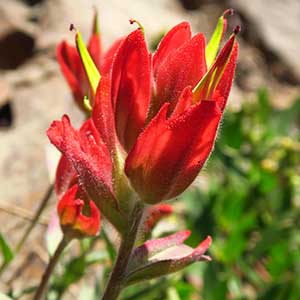Castilleja rhexiifolia
Castilleja elmeri
alpine paintbrush, rhexia-leaf paintbrush, Rocky Mountain paintbrush, rosy paintbrush, split-leaf Indian paintbrush
Elmer's Indian paintbrush, Elmer's paintbrush, Wenatchee Indian paintbrush, Wenatchee paintbrush
few to several, erect or ascending, unbranched, sometimes branched, proximally glabrous to glabrate, distally sparsely hairy, hairs spreading, ± long, soft, eglandular, sometimes stipitate-glandular.
solitary or few to many, erect to ascending, sometimes slightly curved at base, unbranched, rarely branched, hairs moderately dense, spreading, medium length, soft, mixed with shorter eglandular and stipitate-glandular ones, at least on distal 1/2 of stem.
green or purple-tinged, linear, narrowly to broadly lanceolate, oblong, or ovate, 3–6(–7) cm, not fleshy, margins plane, flat to slightly involute, prominently veined, 0(–3)-lobed, apex acute to rarely obtuse;
lobes ascending or spreading, linear to filiform, much smaller than mid blade, short, apex acute.
green, rarely purple-tinged, linear-lanceolate, sometimes linear or lanceolate, 1.3–6.5 cm, not fleshy, margins plane, flat or involute, entire, apex acute.
2.5–15 × 1.5–4.5 cm;
bracts pink-purple, red-purple, purple, or crimson throughout, rarely reddish, yellowish, or white throughout, or proximally greenish, dull brownish purple, or deep purple, distally colored as above, broadly lanceolate to ovate or obovate, (0–)3–5(–7)-lobed;
lobes ascending to erect, linear or lanceolate-acuminate, short, arising near or above mid length, central lobe apex obtuse to broadly rounded, lateral ones acute to sometimes rounded.
2.5–9 × 1.5–3 cm;
bracts red, crimson, scarlet, pink, magenta, red-orange, burnt orange, orange, pale yellow, or whitish throughout, or proximally greenish, distally as stated above, oblong, narrowly obovate, elliptic-oblong, or narrowly ovate, 0(–5)-lobed, rarely with 1 or 2 pairs of short, usually distal lobes;
lobes ascending, lanceolate, very short, arising from distal edge, apex rounded to obtuse.
0 mm.
straight, 15–30(–36) mm;
tube (11–)12–22(–24) mm;
beak exserted, adaxially green, yellow, or tinged with red, 7–12 mm;
abaxial lip deep green, reduced, 1.5–3.5 mm, to 33% as long as beak;
teeth incurved, green or white, 0.5–2 mm.
straight, 20–33 mm;
tubes 13–18 mm;
beak, and sometimes abaxial lip, partially to fully exserted;
beak adaxially green to yellowish, 8–15 mm;
abaxial lip incurved, green, thickened, 2–3 mm, 20–33% as long as beak;
teeth ascending or incurved, green, 0.5–1 mm.
proximally green, purplish, or whitish, distally colored as bracts, 15–25 mm;
abaxial and adaxial clefts 8–12(–15) mm, 40–50% of calyx length, deeper than laterals, lateral 2–5(–8) mm, 15–25(–30)% of calyx length;
lobes oblong to triangular or ovate, apex obtuse to rounded, sometimes acute.
proximally green to pale green, distally colored as bracts, 15–25 mm;
abaxial and adaxial clefts 5–14 mm, 33–50% of calyx length, deeper than laterals, lateral 1–4 mm, 6–20% of calyx length;
lobes lanceolate to narrowly triangular, apex rounded to obtuse.
= 24, 48, 96.
= 48.
Castilleja rhexiifolia
Castilleja elmeri
Castilleja rhexiifolia is a characteristic and common paintbrush in the Rocky Mountains region, from central Alberta to northern New Mexico. Disjunct populations also occur in northeastern Oregon, in the Blue, Ochoco, and Wallowa mountains, as well as near the summit of Abercrombie Mountain in the Selkirk Mountains of northeastern Washington. The inflorescence colors are variable. Typical plants are red-purple. However, many other shades of pink-white, pink-purple, and crimson are common as well. Many populations contain a wide range of color variants. Intergradation is occasionally seen with C. miniata, C. occidentalis, and C. septentrionalis. However, for the most part, these four species remain distinct, and their ranges are not entirely overlapping. In the Wallowa Mountains, a recurrent and variable hybrid form between C. chrysantha and C. rhexiifolia was described as C. wallowensis Pennell. In the north Cascade Range of Washington, plants of C. elmeri with crimson inflorescences are sometimes identified as C. rhexiifolia. In Glacier National Park, Montana, in the vicinity of Logan Pass, C. rhexiifolia frequently hybridizes with C. occidentalis, creating a number of hybrid morphologies. Both of the parents are common in the area. Similar hybrids are also found in the Canadian Rocky Mountains.
(Discussion copyrighted by Flora of North America; reprinted with permission.)
The bracts and inflorescences of Castilleja elmeri can be red, crimson, scarlet, pink, magenta, red-orange, burnt orange, orange, pale yellow, or whitish. While the coloration is highly variable between local populations, it is usually uniform and consistent within them. It is found primarily in the Wenatchee Mountains of Washington, where it is often on serpentine, but it ranges northward in the Cascades into extreme southern British Columbia, apparently on non-serpentine substrates. Hybrids with C. miniata var. miniata, C. parviflora var. albida, and C. thompsonii have been found in the eastern Cascades of Washington, and a similar hybrid swarm with C. thompsonii is reported from southern British Columbia.
(Discussion copyrighted by Flora of North America; reprinted with permission.)


